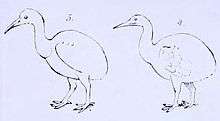Rodrigues rail
| Rodrigues rail | |
|---|---|
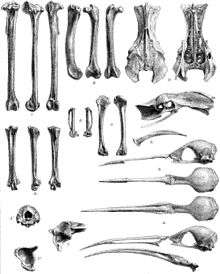 | |
| Subfossil bones described in 1879; note that one skull has a straight beak, while that of the other is curved. The carpometacarpus bone (G.) at the middle left is now thought to belong to a different species of bird | |
| Scientific classification | |
| Kingdom: | Animalia |
| Phylum: | Chordata |
| Class: | Aves |
| Order: | Gruiformes |
| Family: | Rallidae |
| Genus: | †Erythromachus Milne-Edwards, 1874 |
| Species: | †E. leguati |
| Binomial name | |
| Erythromachus leguati Milne-Edwards, 1874 | |
| Location of Rodrigues | |
| Synonyms | |
The Rodrigues rail (Erythromachus leguati), also known as Leguat's gelinote, Leguat's rail, or grey rail, is an extinct species of the rail family that was endemic to the Mascarene island of Rodrigues, east of Madagascar in the Indian Ocean. It has sometimes been assigned to the genus Aphanapteryx, along with its close relative the red rail (A. bonasia) of Mauritius, but is generally kept in its own genus, Erythromachus. Their relationship with other rails is unclear. The Rodrigues rail was described as having grey plumage, a red beak, red legs, and a naked red patch around the eye. The beak varied between specimens from straight to curved, but the reason for this is unknown. It was flightless and fed on tortoise eggs. It was described as being attracted to red objects, which humans exploited while hunting it.
The Rodrigues rail is believed to have become extinct in the mid-18th century because of predation by introduced cats and destruction of its habitat by tortoise hunters. Apart from information gathered from subfossil bones, the bird is poorly known and was only documented from life by two contemporaneous accounts, but no such illustrations. The bird was first mentioned by François Leguat, a French Huguenot refugee marooned on Rodrigues in 1691, and was named E. leguati in his honour in 1874. The second account was by Julien Tafforet, also marooned on the island in 1726. Subfossil remains were later discovered and connected with the old accounts.
Taxonomy
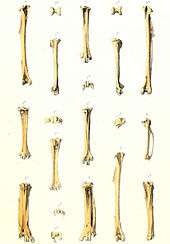
In 1848, the English zoologist Hugh Edwin Strickland called attention to a bird mentioned in the French traveller François Leguat's 1708 memoir about his stay on Rodrigues. Leguat referred to the birds as "gelinottes" (translated as "wood-hens"), a name Strickland thought implied the grouse (Tetraoninae) of Europe, though this was not consistent with the form of the beak described by Leguat. Strickland was unable to classify the bird further, but noted similarities with the dodo (Raphus cucullatus) and kiwi (Apteryx), based on unidentified birds from Mauritius illustrated by the travellers Pieter van den Broecke and Sir Thomas Herbert, which he thought related. Strickland also noted similarities with a bird from Mauritius, which would later be identified as the red rail (Aphanapteryx bonasia).[2][3]
In 1874, the French zoologist Alphonse Milne-Edwards connected Leguat's account with three subfossil bones (a sternum, a tarsometatarsus, and a fragmentary skull) found in a cave on Rodrigues. He recognised their similarity to those of the red rail, while noting it supposedly had a straighter beak (as described by Leguat). Milne-Edwards coined the generic name Erythromachus from the Greek words for "red" and "battle" (also translated as "hostile to red"), in reference to its attraction to red objects, and the specific name is in honour of Leguat. The name Erythromachus was incorrectly explained as referring to the Erythraean sea by the American ornithologist Charles Wallace Richmond in 1908.[4][3] The name Miserythrus, from "red" and "hatred", was used by the English ornithologist Alfred Newton in 1874 (originally only in a manuscript), and also refers to the rail's behaviour towards red, but as a newer name, it is a junior synonym.[3]
In 1875, A. Newton also identified a reference to the bird in the 1726 account of the French traveller Julien Tafforet, which had then recently been rediscovered.[5][6] In 1879, more fossils, including skulls, were described by the zoologists Albert Günther and Edward Newton (brother of Alfred), who confirmed that the bird was a rail (rallidae), but also noted that some specimens had beaks as curved as that of the red rail.[7] The American ornithologist James Greenway suggested that Leguat's description referred to wind-blown purple swamphens (Porphyrio), since the word grey is sometimes used synonymously with blue in old descriptions.[8] This idea has not been accepted by other commentators.[9] In 1999, the French palaeontologist Cécile Mourer-Chauviré and his colleagues pointed out that a carpometacarpus bone assigned to the Rodrigues rail and illustrated by Günther and A. Newton in 1879 does not belong to a rail, and therefore not this bird.[10] More subfossils have since been discovered, including an associated but incomplete skeleton with a complete skull and jaws found in Caverne Poule Rouge in 2005.[11][12]
Evolution
Apart from being a close relative to the red rail, the relationships of the Rodrigues rail are uncertain and the two are commonly listed as separate genera, Aphanapteryx and Erythromachus, but have sometimes been united as species of Aphanapteryx.[13] Günther and E. Newton first generically synonymised the two in 1879 because of their skeletal similarities.[7] In 1945, the French palaeontologist Jean Piveteau found skull features of the two species different enough for generic separation, and in 1977, the American ornithologist Storrs L. Olson stated that though the two species were similar and derived from the same stock, they had also diverged considerably, and should possibly be kept separate. Based on geographic location and the morphology of the nasal bones, Olson suggested that they were related to the genera Gallirallus, Dryolimnas, Atlantisia, and Rallus.[3] Mourer-Chauviré and colleagues also considered the two as belonging to separate genera.[10] Rails have reached many oceanic archipelagos, which has frequently led to speciation and evolution of flightlessness. According to the British researchers Anthony S. Cheke and Julian P. Hume, the fact that the red rail lost much of its feather structure indicates it was isolated for a long time. These rails may be of Asian origin, like many other Mascarene birds.[13]
In 1892, the Scottish naturalist Henry Ogg Forbes described Hawkins's rail, an extinct species of rail from the Chatham Islands, as a new species of Aphanapteryx; A. hawkinsi. He found the Chatham Islands species more similar to the red rail than the latter was to the Rodrigues rail, and proposed that the Mascarene Islands had once been connected with the Chatham Islands. These ideas were later criticised by writers such as the British palaeontologist Charles William Andrews and the German ornithologist Hans Friedrich Gadow, and the bird was moved to its own genus, Diaphorapteryx.[14][15][16]
Description
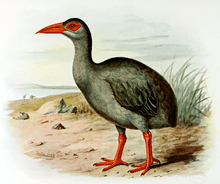
The Rodrigues rail was a flightless rail with bright grey plumage, perhaps flecked with white. Its beak and legs were red, and it had a red, naked area (or wattle) around its eyes. Its exact size is unknown, but it was about the size of a chicken, and somewhat smaller than the related red rail. Subfossil remains exhibit a large variation in size, which may reflect sexual dimorphism. The cranium of the Rodrigues rail was slightly elongate, convex in every direction, and was 38 mm (1.5 in) long and 20 mm (0.79 in) wide. The cranium had a narrow, long frontal region, 6.5 mm (0.26 in) at its least width. The beak varied greatly in size and shape; some specimens had short and almost straight beaks, and others had much longer beaks (up to one third longer) that were prominently curved. It is unknown whether this was related to the overall size of an individual bird or to sexual dimorphism.[7][9][13][11] The culmen of the beak was almost straight above the nostril, and the nasal bone was slightly longer than the cranium. The beak was up to 77 mm (3.0 in) long, the lower jaw up to 98 mm (3.9 in) long, and 8 mm (0.31 in) at its greatest depth. The scapula (shoulder blade) was 45 mm (1.8 in) long, the humerus ranged from 45 to 50 mm (1.8 to 2.0 in), and the ulna from 37 to 42 mm (1.5 to 1.7 in). The pelvis was large and strongly built in proportion to the size of the bird, was 57 mm (2.2 in) long, 20 mm (0.79 in) wide at the front, and 36 mm (1.4 in) wide at the back. The femur ranged from 56 to 63 mm (2.2 to 2.5 in) in length, the tibia from 84 to 101 mm (3.3 to 4.0 in), and the metatarsus was 52 to 60 mm (2.0 to 2.4 in) long.[7]
The proportions of the legs, pelvis and sacrum of the Rodrigues and red rail were generally similar.[7][17] The Rodrigues rail differed from the red rail by having a broader and shorter skull, longer and lower nostrils, a proportionately longer humerus, a shorter, stouter femur, as well as a considerably different plumage, based on early descriptions.[3][10]
Contemporary accounts
The Rodrigues rail was first recorded by Leguat in his 1708 memoir, A New Voyage to the East Indies. Leguat was the leader of a group of nine French Huguenot refugees; the group were the first to colonise Rodrigues from 1691 to 1693, after they were marooned there by their captain.[9][18] Leguat's observations are considered some of the first cohesive accounts of animal behaviour in the wild.[13]
Leguat's full account of the bird reads as follows:
Our 'gelinotes' are fat all the year round and of a most delicate taste. Their colour is always of a bright grey, and there is very little difference in plumage between the two sexes. They hide their nests so well that we could not find them out, and consequently did not taste their eggs. They have a red naked area round their eyes, their beaks are straight and pointed, near two and two-fifths inches long, and red also. They cannot fly, their fat makes them too heavy for it. If you offer them anything red, they are so angry they will fly at you to catch it out of your hand, and in the heat of the combat we had an opportunity to take them with ease.[19]
Another description of appearance and behaviour is found in a document called Relation de l'Ile Rodrigue attributed to Tafforet, who was marooned on Rodrigues in 1726:
There is a sort of bird, of the size of a young hen, which has the beak and feet red. Its beak is a little like that of a curlew, excepting that it is slightly thicker and not quite so long. Its plumage is spotted with white and grey. They generally feed on the eggs of the land tortoises, which they find in the ground, which makes them so fat that they often have difficulty running. They are very good to eat, and their fat is of a yellowish red, which is excellent for pains. They have small pinions [wings], without feathers, on which account they cannot fly; but on the other hand, they run very well. Their cry is a continual whistling. When they see any one who pursues them they produce another sort of noise, like that of a person who has hiccups.[13]
Unlike the red rail and other extinct Mascarene birds, the Rodrigues rail was not illustrated by contemporaneous artists. Olson described reconstructions made for the British zoologist Walter Rothschild's 1907 book Extinct Birds and the Japanese ornithologist Masauji Hachusika's 1953 book The Dodo and Kindred Birds as "rather fanciful". The English artist Frederick William Frohawk based his restoration in the former book on an outline illustration, which was in turn based on a sketch drawn by Herbert, which is now known to depict the red rail.[3][19] The German zoologist Hermann Schlegel thought it depicted a species of dodo (which he called Didus herbertii) from Rodrigues when he drew the outline in 1854, and that it was the species mentioned by Leguat.[20]
Behaviour and ecology
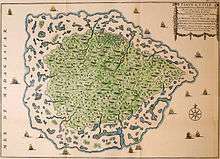
According to Tafforet's account, the Rodrigues rail fed and fattened itself on the eggs of the now extinct Cylindraspis tortoises; it is possible that the bird became fat seasonally. If the length and curvature of the beaks was sexually dimorphic, it may have reflected their diet. Like the red rail, it was said to be attracted to the colour red, but the significance of this is unknown.[9][13] According to Milne-Edwards, the bird had legs "made for running".[19]
Many other species endemic to Rodrigues became extinct after humans arrived, and the island's ecosystem was heavily damaged. Before humans arrived, forests covered the island entirely, but very little of those remain today. The Rodrigues rail lived alongside other recently extinct birds, such as the Rodrigues solitaire (Pezophaps solitaria), the Rodrigues parrot (Necropsittacus rodricanus), Newton's parakeet (Psittacula exsul), the Rodrigues starling (Necropsar rodericanus), the Rodrigues owl (Mascarenotus murivorus), the Rodrigues night heron (Nycticorax megacephalus), and the Rodrigues pigeon (Nesoenas rodericanus). Extinct reptiles include the domed Rodrigues giant tortoise (Cylindraspis peltastes), the saddle-backed Rodrigues giant tortoise (Cylindraspis vosmaeri), and the Rodrigues day gecko (Phelsuma edwardnewtoni).[13]
Extinction
The rapid disappearance of the Rodrigues rail may have been caused by introduced cats, but it is also possible that deforestation by tortoise hunters may have contributed significantly; from 1735, these hunters burned off forests so they could collect giant Cylindraspis tortoises for their meat and oil. The French astronomer Alexandre Guy Pingré, who visited Rodrigues to observe the 1761 transit of Venus, wrote in 1763 that the bird was extinct by the time of his visit.[6]
References
- ↑ BirdLife International (2016). "Erythromachus leguati". The IUCN Red List of Threatened Species. 2016: e.T22728889A94999834. doi:10.2305/IUCN.UK.2016-3.RLTS.T22728889A94999834.en. Retrieved 9 January 2018.
- ↑ Strickland, H. E.; Melville, A. G. (1848). The Dodo and its Kindred; or, The History, Affinities, and Osteology of the Dodo, Solitaire, and other Extinct Birds of the Islands Mauritius, Rodriguez and Bourbon. Reeve, Benham and Reeve. pp. 55–56. doi:10.5962/bhl.title.43794.
- 1 2 3 4 5 6 Olson, S. (1977). "A synopsis on the fossil Rallidae". In Ripley, S. D. Rails of the World – A Monograph of the Family Rallidae. Boston: Codline. pp. 357–363. ISBN 978-0-87474-804-8.
- ↑ Milne-Edwards, A. (1866–1873). Recherches sur la faune ornithologique éteinte des iles Mascareignes et de Madagascar (in French). Paris: G. Masson. pp. 122–123.
- ↑ Newton, A. (1875). "Additional evidence as to the original fauna of Rodriguez". Proceedings of the Zoological Society of London: 39–43.
- 1 2 Hume, J. P.; Walters, M. (2012). Extinct Birds. A & C Black. p. 110. ISBN 978-1-4081-5725-1.
- 1 2 3 4 5 Günther, A.; Newton, E. (1879). "The extinct birds of Rodriguez". Philosophical Transactions of the Royal Society of London. 168: 423–437. doi:10.1098/rstl.1879.0043.
- ↑ Greenway, J. C. (1967). Extinct and Vanishing Birds of the World. New York: American Committee for International Wild Life Protection. pp. 117–119. ISBN 978-0-486-21869-4.
- 1 2 3 4 Fuller, E. (2001). Extinct Birds (revised ed.). Comstock. pp. 149–151. ISBN 978-0-8014-3954-4.
- 1 2 3 Mourer-Chauvire, C.; Bour, R.; Ribes, S.; Moutou, F. (1999). "Avian paleontology at the close of the 20th century: The avifauna of Réunion Island (Mascarene Islands) at the time of the arrival of the first Europeans". Smithsonian Contributions to Paleobiology. 89: 23. hdl:10088/2005.
- 1 2 Hume, J. P. (2013). Göhlich, U. B.; Kroh, A., eds. "A synopsis of the pre-human avifauna of the Mascarene Islands" (PDF). Proceedings of the 8th International Meeting of Society of Avian Paleontology and Evolution: 195–237.
- ↑ Cowles, G. S. (1987). "The fossil record". In Diamond, A. W. Studies of Mascarene Island Birds. Cambridge. pp. 90–100. doi:10.1017/CBO9780511735769.004. ISBN 9780511735769.
- 1 2 3 4 5 6 7 Cheke, A. S.; Hume, J. P. (2008). Lost Land of the Dodo: an Ecological History of Mauritius, Réunion & Rodrigues. New Haven and London: T. & A. D. Poyser. pp. 45, 49–52, 127. ISBN 978-0-7136-6544-4.
- ↑ Forbes, H. O. (1893). "Mr. H. O. Forbes's discoveries in the Chatham Islands". Nature. 48 (1230): 74–75. Bibcode:1893Natur..48...74F. doi:10.1038/048074c0.
- ↑ Forbes, H. O. (1893). "Mr. H. O. Forbes's discoveries in the Chatham Islands". Nature. 48 (1232): 126. Bibcode:1893Natur..48..126F. doi:10.1038/048126a0.
- ↑ Andrews, C. W. (1896). "On the extinct birds of the Chatham Islands. Part I.: The osteology of Diaphorapteryx hawkinsi". Novitates Zoologicae. 73–84: 72.
- ↑ Newton, E.; Gadow, H. (1893). "IX. On additional bones of the Dodo and other extinct birds of Mauritius obtained by Mr. Theodore Sauzier". The Transactions of the Zoological Society of London. 13 (7): 281–302. doi:10.1111/j.1469-7998.1893.tb00001.x.
- ↑ Leguat, F. (1891). Oliver, S. P., ed. The voyage of François Leguat of Bresse, to Rodriguez, Mauritius, Java, and the Cape of Good Hope. Volume 1. London: Hakluyt Society. p. 81.
- 1 2 3 Rothschild, W. (1907). Extinct Birds. London: Hutchinson & Co. p. 135.
- ↑ Schlegel, H. (1854), "Ook een Woordje over den Dodo (Didus ineptus) en zijne Verwanten", Verslagen en Mededeelingen der Koninklijke Akademie van Wetenschappen (in Dutch), 2: 232–256
External links



